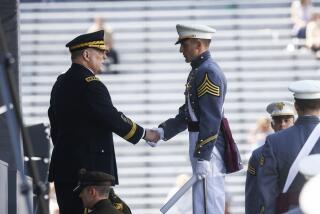Second Arms Race
- Share via
A Washington audience spent three days this week listening to speakers attempt to pin down what there is to show for five years of work on President Reagan’s “Star Wars” missile defense project.
What there is, as nearly as we can tell, is a plan to put a 20th-Century equivalent of bows and arrows into orbit and then let the history of weapons development repeat itself, this time in outer space. That kind of competition on Earth gave the world intercontinental missiles with thermonuclear warheads. The question of what infernal device a competition in space might produce did not come up at the conference.
Congress should not commit America to a second arms race when it can’t afford the one in which it already is running. Congress should instead insist that the development of any defensive system proceed under firm rules covering both the United States and the Soviet Union. It should approve nothing that diverts either country from the most important business at hand--making severe cuts in nuclear arsenals.
That can easily be done with no damage to national security by returning the Star Wars project to the status of a serious research program that it enjoyed for 20 or so years before it was turned into a public-relations spectacle more useful in politics than in military planning. It also can be done at about half, or less, the present cost of nearly $4 billion a year.
Such a course would not please this week’s audience of true believers in Star Wars, for whom the focus was on the next technically sweet device that will burst from the laboratories. The keynote address was delivered by the President, the truest believer of all, who put Star Wars into the political fast lane with a speech on March 23, 1983, challenging science to find a way to make nuclear weapons impotent and obsolete--in effect, to build a shield over the United States.
Another believer, Edward Teller, director emeritus of Lawrence Livermore Laboratory in California, preceded Reagan with a call for a bigger Star Wars budget and reassurance that the nation is moving to something useful--but perhaps not to “the President’s umbrella.”
Like Teller, Lowell Wood, senior staff physicist at Livermore, believed mere months ago that the future of Star Wars lay in nuclear-powered laser beams in space. Both told the Washington conference that they now think it lies in a system that sounds less like Star Wars and more like a swarm of space gnats. The vision is of 100,000 platforms, each so completely computerized that it could spot a missile leaving a Soviet silo and blow it up without orders from the United States.
Before long another speaker said that the 100,000 platforms could hold off nuclear war all by themselves only for so many years before they would need replacing--or at least reinforcing with better technology as the Soviets changed missile tactics. And so on into the indefinite future.
The most optimistic speakers agreed that much work needs to be done. And the stories sometimes differed on details. The President, for example, said that the last $250-million Star Wars test demonstrated that American technology can distinguish between decoys and real Soviet warheads. Lt. Gen. James A. Abrahamson, head of the Strategic Defense Initiative Organization, said that the test demonstrated only that “there is a way” to tell them apart.
Despite the anniversary rhetoric, five years have not led even to a design for something that could make nuclear weapons obsolete. Abrahamson, in fact, says that he would settle for a first phase that would make Soviet targeters wonder how many missiles would get through the defense.
It probably did no harm for the speakers to spend three days fantasizing about a world that had no cause to worry about nuclear weapons. But, at this stage of the nuclear arms race, time is better spent talking to the Soviets about arms control and getting both offensive and defensive weapons under firm control and written into treaties.A model for that kind of conversation would be the unprecedented meeting in Europe last week between U.S. Defense Secretary Frank C. Carlucci and Soviet Defense Minister Dmitri T. Yazov.
More to Read
Sign up for Essential California
The most important California stories and recommendations in your inbox every morning.
You may occasionally receive promotional content from the Los Angeles Times.









